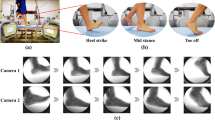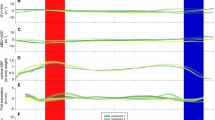Abstract
Use of subject-specific axes of rotation may improve predictions generated by kinematic models, especially for joints with complex anatomy, such as the tibiotalar and subtalar joints of the ankle. The objective of this study was twofold. First, we compared the axes of rotation between generic and subject-specific ankle models for ten control subjects. Second, we quantified the accuracy of generic and subject-specific models for predicting tibiotalar and subtalar joint motion during level walking using inverse kinematics. Here, tibiotalar and subtalar joint kinematics measured in vivo by dual-fluoroscopy served as the reference standard. The generic model was based on a cadaver study, while the subject-specific models were derived from each subject’s talus reconstructed from computed tomography images. The subject-specific and generic axes of rotation were significantly different. The average angle between the modeled axes was 12.9° ± 4.3° and 24.4° ± 5.9° at the tibiotalar and subtalar joints, respectively. However, predictions from both models did not agree well with dynamic dual-fluoroscopy data, where errors ranged from 1.0° to 8.9° and 0.6° to 7.6° for the generic and subject-specific models, respectively. Our results suggest that methods that rely on talar morphology to define subject-specific axes may be inadequate for accurately predicting tibiotalar and subtalar joint kinematics.






Similar content being viewed by others
References
Arnold, E. M., S. R. Ward, R. L. Lieber, and S. L. Delp. A model of the lower limb for analysis of human movement. Ann. Biomed. Eng. 38:269–279, 2010.
Beimers, L., G. J. Tuijthof, L. Blankevoort, R. Jonges, M. Maas, and C. N. van Dijk. In-vivo range of motion of the subtalar joint using computed tomography. J. Biomech. 41:1390–1397, 2008.
Bey, M. J., R. Zauel, S. K. Brock, and S. Tashman. Validation of a new model-based tracking technique for measuring three-dimensional, in vivo glenohumeral joint kinematics. J. Biomech. Eng. 128:604–609, 2006.
Bland, J. M., and D. G. Altman. Measuring agreement in method comparison studies. Stat. Methods Med. Res. 8:135–160, 1999.
Chang, L. Y., and N. S. Pollard. Method for determining kinematic parameters of the in vivo thumb carpometacarpal joint. IEEE Trans. Biomed. Eng. 55:1897–1906, 2008.
Delp, S. L., F. C. Anderson, A. S. Arnold, P. Loan, A. Habib, C. T. John, E. Guendelman, and D. G. Thelen. Opensim: open-source software to create and analyze dynamic simulations of movement. IEEE Trans. Biomed. Eng. 54:1940–1950, 2007.
Engsberg, J. R. A biomechanical analysis of the talocalcaneal joint–in vitro. J. Biomech. 20:429–442, 1987.
Fisher, N. I., T. L. Lewis, and B. J. J. Embleton. Analysis of Two or more Samples of Vectoral or Axial Data. Statistical Analysis of Sphereical Data. Cambridge: Press Syndicate of the University of Cambridge, pp. 194–229, 1989.
Inman, V. T. The Joints of the Ankle. Baltimore: Williams & Wilkins, 1976.
Isman, R. E., and V. T. Inman. Anthropometric studies of the human foot and ankle. Bull. Prosthet. Res. 11(97):129, 1969.
Jennings. Sphere fit (least squares). 2013. https://www.mathworks.com/matlabcentral/fileexchange/34129-sphere-fit--least-squared, Accessed Feb 22, 2016.
Kadaba, M. P., H. K. Ramakrishnan, and M. E. Wootten. Measurement of lower extremity kinematics during level walking. J. Orthop. Res. 8:383–392, 1990.
Leardini, A., J. J. O’Connor, F. Catani, and S. Giannini. A geometric model of the human ankle joint. J. Biomech. 32:585–591, 1999.
Leardini, A., R. Stagni, and J. J. O’Connor. Mobility of the subtalar joint in the intact ankle complex. J. Biomech. 34:805–809, 2001.
Lewis, G. S., T. L. Cohen, A. R. Seisler, K. A. Kirby, F. T. Sheehan, and S. J. Piazza. In vivo tests of an improved method for functional location of the subtalar joint axis. J. Biomech. 42:146–151, 2009.
Lewis, G. S., S. J. Piazza, and I. H. J. Sommer. In vitro assessment of a motion-based optimization method for locating the talocrural and subtalar joint axes. J. Biomech. Eng. 128:596–603, 2006.
Lunberg, A., and O. K. Svensson. The axes of rotation of the talocalcaneal and talonavicular joints. Foot 3:65–70, 1993.
Maas, S. A., B. J. Ellis, G. A. Ateshian, and J. A. Weiss. Febio: finite elements for biomechanics. J. Biomech. Eng. 134:011005, 2012.
Manter, J. T. Movements of the subtalar and transverse tarsal joints. Anat. Record. 80:397–410, 1941.
Nester, C. Review of literature on the axis of rotation at the subtalar joint. Foot 8:111–118, 1998.
Nester, C., R. K. Jones, A. Liu, D. Howard, A. Lundberg, A. Arndt, P. Lundgren, A. Stacoff, and P. Wolf. Foot kinematics during walking measured using bone and surface mounted markers. J. Biomech. 40:3412–3423, 2007.
Nichols, J. A., M. S. Bednar, R. M. Havey, and W. M. Murray. Decoupling the wrist: a cadaveric experiment examining wrist kinematics following midcarpal fusion and scaphoid excision. J. Appl. Biomech. 1–29, 2016.
Nichols, J. A., K. E. Roach, N. M. Fiorentino, and A. E. Anderson. Predicting tibiotalar and subtalar joint angles from skin-marker data with dual-fluoroscopy as a reference standard. Gait Posture. 49:136–143, 2016.
Nozaki, S., K. Watanabe, and M. Katayose. Three-dimensional analysis of talar trochlea morphology: implications for subject-specific kinematics of the talocrural joint. Clin. Anat. 29:1066–1074, 2016.
Oatis, C. A. Biomechanics of the foot and ankle under static conditions. Phys. Ther. 68:1815–1821, 1988.
Parr, W. C., H. J. Chatterjee, and C. Soligo. Calculating the axes of rotation for the subtalar and talocrural joints using 3d bone reconstructions. J. Biomech. 45:1103–1107, 2012.
Piaggio, G., D. R. Elbourne, D. G. Altman, S. J. Pocock, S. J. Evans, and C. Group. Reporting of noninferiority and equivalence randomized trials: an extension of the consort statement. JAMA. 295:1152–1160, 2006.
Reinbolt, J. A., J. F. Schutte, B. J. Fregly, B. I. Koh, R. T. Haftka, A. D. George, and K. H. Mitchell. Determination of patient-specific multi-joint kinematic models through two-level optimization. J. Biomech. 38:621–626, 2005.
Roach, K. E., B. Wang, A. L. Kapron, N. M. Fiorentino, C. L. Saltzman, K. B. Foreman, and A. E. Anderson. In vivo kinematics of the tibiotalar and subtalar joints in asymptomatic subjects: a high-speed dual fluoroscopy study. J. Biomech. Eng. 138(9):091006, 2016.
Rome, K., and F. Cowieson. A reliability study of the universal goniometer, fluid goniometer, and electrogoniometer for the measurement of ankle dorsiflexion. Foot Ankle Int. 17:28–32, 1996.
Schwartz, M. H., and A. Rozumalski. A new method for estimating joint parameters from motion data. J. Biomech. 38:107–116, 2005.
Sheehan, F. T., A. R. Seisler, and K. L. Siegel. In vivo talocrural and subtalar kinematics: a non-invasive 3d dynamic mri study. Foot Ankle Int. 28:323–335, 2007.
Siegler, S., J. Chen, and C. D. Schneck. The three-dimensional kinematics and flexibility characteristics of the human ankle and subtalar joints–part I: kinematics. J. Biomech. Eng. 110:364–373, 1988.
Tulchin, K., M. Orendurff, and L. Karol. A comparison of multi-segment foot kinematics during level overground and treadmill walking. Gait Posture. 31:104–108, 2010.
Tumer, N., L. Blankevoort, M. van de Giessen, M. P. Terra, P. A. de Jong, H. Weinans, G. J. Tuijthof, and A. A. Zadpoor. Bone shape difference between control and osteochondral defect groups of the ankle joint. Osteoar. Cartil. 24:2108–2115, 2016.
van den Bogert, A. J., G. D. Smith, and B. M. Nigg. In vivo determination of the anatomical axes of the ankle joint complex: an optimization approach. J. Biomech. 27:1477–1488, 1994.
Wang, B., K. E. Roach, A. L. Kapron, N. M. Fiorentino, C. Saltzman, M. Singer, and A. E. Anderson. Accuracy and feasibility of high-speed dual fluoroscopy and model-based tracking to measure in vivo ankle arthrokinematics. Gait Posture. 41:888–893, 2015.
Acknowledgments
This work was supported by grants from the National Institutes of Health (R21 AR069773, R21 AR063844, S10 RR026565, F32 AR067075), the LS-Peery Discovery Program in Musculoskeletal Restoration, the American Orthopaedic Foot & Ankle Society, and the Orthopaedic Research and Education Foundation with funding from the Orthopaedic Research Society. The content is solely the responsibility of the authors and does not necessarily represent the official views of these funding sources. We thank K. Bo Foreman, Justine Goebel, Ashley Kapron, Bibo Wang, and Austin West for assistance collecting and processing the experimental data. We also thank Greg Stoddard for feedback regarding our statistical analyses as well as Glen Litchwark and Tim Dorn for their open-source OpenSim toolboxes, which were adapted to facilitate batch processing of our computer simulations.
Conflict of interest
The corresponding author and co-authors do not have a conflict of interest, financial or otherwise, that would inappropriately influence or bias the research reported herein.
Author information
Authors and Affiliations
Corresponding author
Additional information
Associate Editor Michael R. Torry oversaw the review of this article.
Rights and permissions
About this article
Cite this article
Nichols, J.A., Roach, K.E., Fiorentino, N.M. et al. Subject-Specific Axes of Rotation Based on Talar Morphology Do Not Improve Predictions of Tibiotalar and Subtalar Joint Kinematics. Ann Biomed Eng 45, 2109–2121 (2017). https://doi.org/10.1007/s10439-017-1874-9
Received:
Accepted:
Published:
Issue Date:
DOI: https://doi.org/10.1007/s10439-017-1874-9




